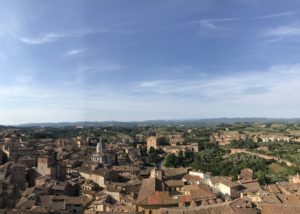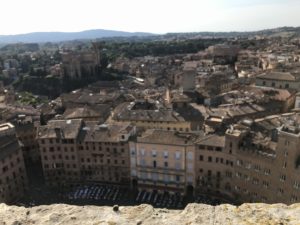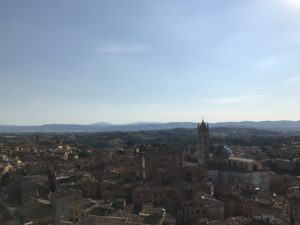


On my morning walk from Casa di Alfredo to the Dante Alighieri School, I pass through five unique zones of the city, discernible by my five senses. I observe different activities in various parts of the city by tasting, touching, hearing, smelling, and seeing.
First, I wake up in the residential neighborhood outside the city’s north gate. I become aware of nonna and Antonella chatting excitedly in their thick Sienese accents. Outside my window, I hear the other guests conversing in rapid Korean. Already, I am immersed in a foreign sea of sound (for an American, most any European city offers greater diversity than at home. In the Bed and Breakfast alone, I have met people from Japan and Mexico, and at school, I have met people from Australia, England, Switzerland, France, Canada, and Austria). As I walk into the dining room, my nose is all but overwhelmed with the aroma of fresh sausage, espresso, Parmesan, warm milk, Nutella torte, and poorly made Americano coffee. The familiar tastes of nonna’s fresh bruschetta, plums, and salami excite my taste buds and draw from me the last visages of sleep.
I can tell I have left the residential quarter as soon as I step out of the wrought iron gate of Casa di Alfredo. Busses, cars, and Vespas roar up and down the hill traversed by Viale Don Giovanni Minzoni as the drivers honk their horns and make some of the rude gesticulations I have learned about in class. As I timidly stand on the curb waiting for a traversable gap in traffic, I inhale the exhaust from cars and feel the heat from their tail pipes. Alternatively, in situations where I am late for school, I sprint wildly across the congested street as eager tourists in busses and yawning, suited Italians on Vespas alike watch with respective horror and approval. In either case, when I reach Via Camollia, I know immediately I have reached the third stage of my journey.
I pass a shop that sells bikes, one with fresh wild boar in the window, one with overflowing boxes of fruit stacked outside, and one that sells swords, maces, and armor. The proprietor of the tobacco store wearing – what I have observed over the past five weeks to be – his favorite white dress shirt and cargo shorts sits sipping a café across the street from his shop. In this zone, life seems more naturally organized: the pedestrians, Vespas, and few cars weave in between each other in an unregulated but sensible pattern, without silly contrivances like traffic lights and stop signs. A car rolls around a corner then gently inches forward to avoid a woman crossing the intersection – but just barley. Vespas, garbage trucks, street cleaners, and all manner of automobiles and mounted police somehow navigate a street built for less activity. I comprehend snatches of conversation and odd words spoken by the Italians opening their shops or rushing to work while chattering on the phone, and easily recognize the tourists already blindfolded by their maps, weighed down by backpacks, and speaking in their vulgar, grating American English. As I enter Piazza Salimbeni, to my left I hear the jangle of the beggar’s first or last few coins as he twirls them back and forth with his calloused hands and sits on a ledge outside a shop. To my right, I see the newest street art edition: a rather emotive rendition of Vermeer’s “Girl with a Pearl Earring”.
Suddenly, a shop owner throws a bucket of water into the street that nearly misses my shoes. As she begins to sweep the street clean I realize that I have now begun the fourth more metropolitan segment of my journey. It is almost a surprise, still, that as a truck rumbles behind me waiting to pass a large crowd of pedestrians, I look to the left and above the arches of the Palazzo soars the iconic tower. My calves strain and my shirt becomes damp with sweat as I climb the hill with Accademia Musicale Chigiana on my left. An owl hoots as I recall the baroque theater in the Chigiana in which I heard string quartets from France, Japan, and Italy play a concert the other night.
Finally, walking under the Virgin Mary enthroned next to the street sign above the Trattorias and tourist traps in Pantera territory, I reach the fifth and final leg of my journey. This residential quarter is quiet at all hours of the day and the parked cars and Vespas look almost out of place between the narrow medieval walls. A family sits smoking on their steps and I greet them with a friendly “buona giornata”.
As I approach the School, I think of the heated debate Christophero and I have carried on since the first day of class about the fastest route from Casa di Alfredo to Dante Alighieri. Perhaps my route following Via di Città is longer than his that snakes behind the Duomo. I take my path everyday, however, not because it’s familiar and straightforward, but because it is never exactly the same. The shopkeepers I recognize will always have different expressions and the students and professionals on their way to work (some of whom pass and greet me in the street everyday) will never be dressed in the same way or thinking the same thoughts. The fruit store will never have the same selection of fruit it does today, and the water the shopkeepers use to clean the street in front of their businesses will never run down the street and dry in the same pattern. When one follows the same path everyday, he begins to see Siena as more than a compilation of buildings, museums, and churches, but rather as a living body – of citizens, tourists, and students – constantly growing, changing, and thriving.
Arrivo alla scuola presto e poi, mi sveglio nella Casa di Alfredo.